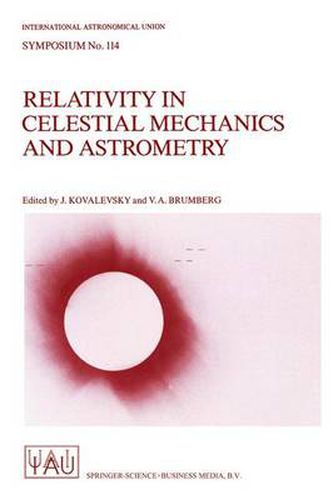Readings Newsletter
Become a Readings Member to make your shopping experience even easier.
Sign in or sign up for free!
You’re not far away from qualifying for FREE standard shipping within Australia
You’ve qualified for FREE standard shipping within Australia
The cart is loading…






This title is printed to order. This book may have been self-published. If so, we cannot guarantee the quality of the content. In the main most books will have gone through the editing process however some may not. We therefore suggest that you be aware of this before ordering this book. If in doubt check either the author or publisher’s details as we are unable to accept any returns unless they are faulty. Please contact us if you have any questions.
The driving idea, in organizing this Symposium on Relativity in Celestial Mechanics . and Astrometry was that, in recent years, the ac curacy of several Astrometric techniques has so much increased that re lativistic effects are no more marginally mentioned in academic presen tations but have become an intrinsic part of the interpretation of all the positional data. Techniques such as V. L. B. I. , space probes, lunar lasers, etc … have greatly contributed to reduce the accuracy level to an angular equivalent of a few milliarc-seconds. HIPPARCOS will extend this trend to stellar astrometry and new proposals aim at gaining ano ther one or two orders of magnitude in observing precision. In paral lel, great progress has also been made in the theories of motion of ce lestial bodies and more rigourous treatments within the frame of general relativity become necessary. The definition of reference frames and of various coordinate times become also a major problem in the intercompa rison of observations produced by different methods. This Symposium gave to people using relativistic corrections in reducing their measurements or in constructing various theories of mo tion a chance to exchange their experience in the field and to confront it with theoreticians in general relativity. The Symposium was approved by the IAU in 1983 and it was organi zed by the Institute of Theoretical Astronomy of the USSR Academy of Sciences on May 28-31, 1985.
$9.00 standard shipping within Australia
FREE standard shipping within Australia for orders over $100.00
Express & International shipping calculated at checkout
This title is printed to order. This book may have been self-published. If so, we cannot guarantee the quality of the content. In the main most books will have gone through the editing process however some may not. We therefore suggest that you be aware of this before ordering this book. If in doubt check either the author or publisher’s details as we are unable to accept any returns unless they are faulty. Please contact us if you have any questions.
The driving idea, in organizing this Symposium on Relativity in Celestial Mechanics . and Astrometry was that, in recent years, the ac curacy of several Astrometric techniques has so much increased that re lativistic effects are no more marginally mentioned in academic presen tations but have become an intrinsic part of the interpretation of all the positional data. Techniques such as V. L. B. I. , space probes, lunar lasers, etc … have greatly contributed to reduce the accuracy level to an angular equivalent of a few milliarc-seconds. HIPPARCOS will extend this trend to stellar astrometry and new proposals aim at gaining ano ther one or two orders of magnitude in observing precision. In paral lel, great progress has also been made in the theories of motion of ce lestial bodies and more rigourous treatments within the frame of general relativity become necessary. The definition of reference frames and of various coordinate times become also a major problem in the intercompa rison of observations produced by different methods. This Symposium gave to people using relativistic corrections in reducing their measurements or in constructing various theories of mo tion a chance to exchange their experience in the field and to confront it with theoreticians in general relativity. The Symposium was approved by the IAU in 1983 and it was organi zed by the Institute of Theoretical Astronomy of the USSR Academy of Sciences on May 28-31, 1985.